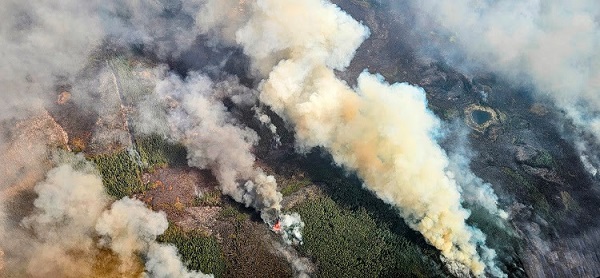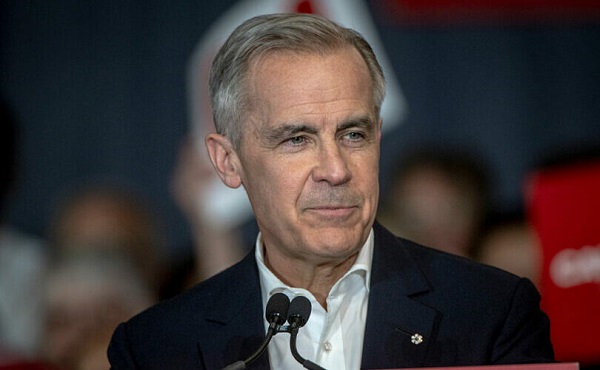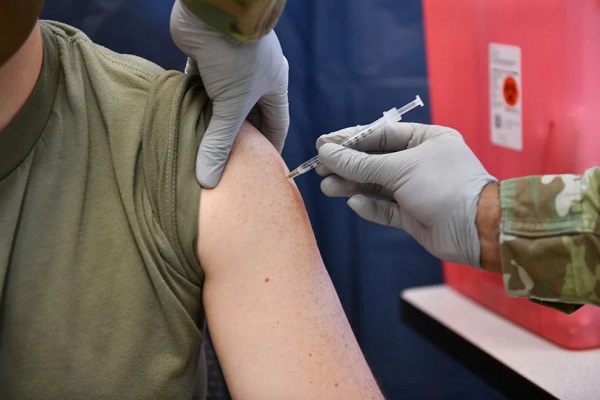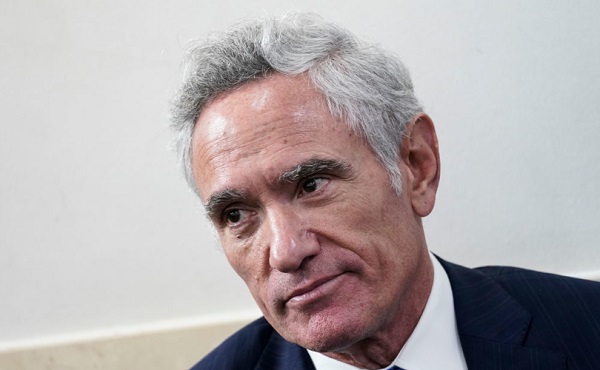Alberta
Preparation, swift response define wildfire season

Aerial view of wildfires near Fox Lake and Garden River in July.
Alberta concludes its 2024 wildfire season with renewed resilience, as vigilance and swift action helped keep communities safe and ready for the future.
Through effective investments, including a historic $155-million wildfire base budget, Alberta’s government ensured the province was prepared to respond throughout the 2024 wildfire season. In anticipation of the wildfire season, Alberta’s government recruited 100 additional wildland firefighters and an additional 40 contract wildland firefighters – in addition to securing more airtankers, heavy equipment, and helicopters equipped with night vision technology. As a result of this preparation, front-line crews were able to respond quickly and fight fires around the clock, containing 85 per cent of wildfires within 24 hours of detection.
“While the 2024 wildfire season was challenging, our coordinated efforts and the resilience of Albertans have been crucial in mitigating the impact. We will continue to adapt and strengthen our wildfire management strategies to protect our communities and natural resources.”
“This wildfire season has tested our resolve, especially in areas like Fox Lake and Jasper. The coordinated efforts of our firefighters and support teams were instrumental in protecting our communities. We will build on this experience to continue to improve response strategies and initiate new strategies to ensure the safety of all Albertans.”
The 2024 wildfire season began earlier than usual, with 64 carryover wildfires stemming from a mild winter and extremely dry conditions. In response to this elevated danger, Alberta’s government activated an early start to the wildfire season on February 20, 2024, implementing a fire ban and fire permit system to prevent additional human-caused wildfires.
Despite significant challenges, including large wildfires near Jasper that led to evacuations and the tragic loss of an Alberta wildland firefighter, as well as the loss of homes and businesses in the community, Alberta Wildfire demonstrated remarkable coordination, offering immediate aid and resources to Parks Canada, including support personnel, firefighters, aircraft and equipment.
While supporting the Jasper response led by Parks Canada, Alberta Wildfire crews continued to tackle substantial wildfires throughout the province, deploying personnel, aircraft and equipment to combat wildfires and assist impacted communities. Throughout the season, residents of Garden River, John D’Or Prairie, Fox Lake in the Little Red River Cree Nation, and the Chipewyan Cree Nation were also evacuated. Additionally, an area near Peace River and four neighborhoods in Fort McMurray faced short-term evacuations due to wildfires.
“In the wake of the heartbreaking loss from the Jasper wildfire, we are reminded of the strength found in collaboration – with each other and among all orders of government. We are reminded also of the compelling need to invest together in training, preparation, mitigation and adaptation, ensuring that we not only respond effectively, but that we also build a more resilient future.”
“The 2024 wildfire season underscored the importance of early planning and preparation. Investments in people, resources and new technology proved invaluable in our response efforts.”
During the 2024 wildfire season, Alberta Wildfire responded to more than 1,210 wildfires in the Forest Protection Area, exceeding last year’s record-breaking total. While the number of fires in 2024 exceeded the total number of fires in 2023, wildfires this season burned less than a third of the area compared with 2023, underscoring the effectiveness of Alberta’s preparation and investments.
Although Oct. 31 marks the end of Alberta’s wildfire season, Alberta Wildfire remains vigilant and ready to respond to any potential wildfires across the province.
Quick Facts
- Alberta Wildfire responded to more than 1,210 wildfires this year with more than 705,000 hectares burned.
- In 2023, there were 1,080 wildfires and more than 2.2 million hectares burned.
- Alberta Wildfire had almost 1,900 firefighters, contractors and support staff working on Alberta’s provincial response.
- Alberta Wildfire also received assistance from other agencies with more than 1,300 firefighters and support staff arriving from around the world to assist.
- While most wildfires were caused by people, we had 410 lightning-caused wildfires in July, the highest number in 20-years.
Related information
Alberta
Alberta takes big step towards shorter wait times and higher quality health care

From the Fraser Institute
On Monday, the Smith government announced that beginning next year it will change the way it funds surgeries in Alberta. This is a big step towards unlocking the ability of Alberta’s health-care system to provide more, better and faster services for the same or possibly fewer dollars.
To understand the significance of this change, you must understand the consequences of the current (and outdated) approach.
Currently, the Alberta government pays a lump sum of money to hospitals each year. Consequently, hospitals perceive patients as a drain on their budgets. From the hospital’s perspective, there’s little financial incentive to serve more patients, operate more efficiently and provide superior quality services.
Consider what would happen if your local grocery store received a giant bag of money each year to feed people. The number of items would quickly decline to whatever was most convenient for the store to provide. (Have a favourite cereal? Too bad.) Store hours would become less convenient for customers, alongside a general decline in overall service. This type of grocery store, like an Alberta hospital, is actually financially better off (that is, it saves money) if you go elsewhere.
The Smith government plans to flip this entire system on its head, to the benefit of patients and taxpayers. Instead of handing out bags of money each year to providers, the new system—known as “activity-based funding”—will pay health-care providers for each patient they treat, based on the patient’s particular condition and important factors that may add complexity or cost to their care.
This turns patients from a drain on budgets into a source of additional revenue. The result, as has been demonstrated in other universal health-care systems worldwide, is more services delivered using existing health-care infrastructure, lower wait times, improved quality of care, improved access to medical technologies, and less waste.
In other words, Albertans will receive far better value from their health-care system, which is currently among the most expensive in the world. And relief can’t come soon enough—for example, last year in Alberta the median wait time for orthopedic surgeries including hip and knee replacements was 66.8 weeks.
The naysayers argue this approach will undermine the province’s universal system and hurt patients. But by allowing a spectrum of providers to compete for the delivery of quality care, Alberta will follow the lead of other more successful universal health-care systems in countries such as Australia, Germany, the Netherlands and Switzerland and create greater accountability for hospitals and other health-care providers. Taxpayers will get a much better picture of what they’re paying for and how much they pay.
Again, Alberta is not exploring an untested policy. Almost every other developed country with universal health care uses some form of “activity-based funding” for hospital and surgical care. And remember, we already spend more on health care than our counterparts in nearly all of these countries yet endure longer wait times and poorer access to services generally, in part because of how we pay for surgical care.
While the devil is always in the details, and while it’s still possible for the Alberta government to get this wrong, Monday’s announcement is a big step in the right direction. A funding model that puts patients first will get Albertans more of the high-quality health care they already pay for in a timelier fashion. And provide to other provinces an example of bold health-care reform.
Alberta
Alberta’s embrace of activity-based funding is great news for patients

 From the Montreal Economic Institute
From the Montreal Economic Institute
Alberta’s move to fund acute care services through activity-based funding follows best practices internationally, points out an MEI researcher following an announcement made by Premier Danielle Smith earlier today.
“For too long, the way hospitals were funded in Alberta incentivized treating fewer patients, contributing to our long wait times,” explains Krystle Wittevrongel, director of research at the MEI. “International experience has shown that, with the proper funding models in place, health systems become more efficient to the benefit of patients.”
Currently, Alberta’s hospitals are financed under a system called “global budgeting.” This involves allocating a pre-set amount of funding to pay for a specific number of services based on previous years’ budgets.
Under the government’s newly proposed funding system, hospitals receive a fixed payment for each treatment delivered.
An Economic Note published by the MEI last year showed that Quebec’s gradual adoption of activity-based funding led to higher productivity and lower costs in the province’s health system.
Notably, the province observed that the per-procedure cost of MRIs fell by four per cent as the number of procedures performed increased by 22 per cent.
In the radiology and oncology sector, it observed productivity increases of 26 per cent while procedure costs decreased by seven per cent.
“Being able to perform more surgeries, at lower costs, and within shorter timelines is exactly what Alberta’s patients need, and Premier Smith understands that,” continued Mrs. Wittevrongel. “Today’s announcement is a good first step, and we look forward to seeing a successful roll-out once appropriate funding levels per procedure are set.”
The governments expects to roll-out this new funding model for select procedures starting in 2026.
* * *
The MEI is an independent public policy think tank with offices in Montreal, Ottawa, and Calgary. Through its publications, media appearances, and advisory services to policymakers, the MEI stimulates public policy debate and reforms based on sound economics and entrepreneurship.
-

 Also Interesting22 hours ago
Also Interesting22 hours agoMortgage Mayhem: How Rising Interest Rates Are Squeezing Alberta Homeowners
-

 2025 Federal Election2 days ago
2025 Federal Election2 days agoMark Carney’s radical left-wing, globalist record proves he is Justin Trudeau 2.0
-

 2025 Federal Election1 day ago
2025 Federal Election1 day agoConservative Party urges investigation into Carney plan to spend $1 billion on heat pumps
-

 2025 Federal Election2 days ago
2025 Federal Election2 days agoDon’t double-down on net zero again
-

 COVID-191 day ago
COVID-191 day agoMassive new study links COVID jabs to higher risk of myocarditis, stroke, artery disease
-

 Alberta1 day ago
Alberta1 day agoAlberta’s embrace of activity-based funding is great news for patients
-

 2025 Federal Election1 day ago
2025 Federal Election1 day agoCommunist China helped boost Mark Carney’s image on social media, election watchdog reports
-

 Censorship Industrial Complex2 days ago
Censorship Industrial Complex2 days agoScott Atlas: COVID lockdowns, censorship have left a ‘permanent black mark on America’






